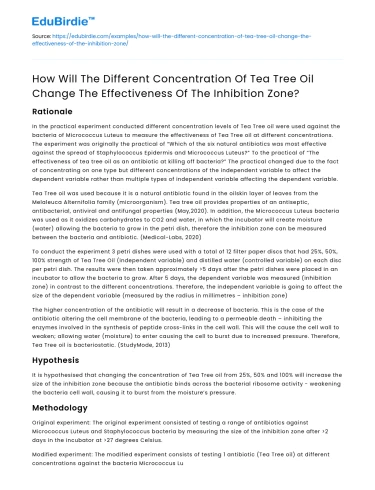Rationale
In the practical experiment conducted different concentration levels of Tea Tree oil were used against the bacteria of Micrococcus Luteus to measure the effectiveness of Tea Tree oil at different concentrations. The experiment was originally the practical of “Which of the six natural antibiotics was most effective against the spread of Staphylococcus Epidermis and Micrococcus Luteus?” To the practical of “The effectiveness of tea tree oil as an antibiotic at killing off bacteria?” The practical changed due to the fact of concentrating on one type but different concentrations of the independent variable to affect the dependent variable rather than multiple types of independent variable affecting the dependent variable.
Tea Tree oil was used because it is a natural antibiotic found in the oilskin layer of leaves from the Melaleuca Alternifolia family (microorganism). Tea tree oil provides properties of an antiseptic, antibacterial, antiviral and antifungal properties (May,2020). In addition, the Micrococcus Luteus bacteria was used as it oxidizes carbohydrates to CO2 and water, in which the incubator will create moisture (water) allowing the bacteria to grow in the petri dish, therefore the inhibition zone can be measured between the bacteria and antibiotic. (Medical-Labs, 2020)
Save your time!
We can take care of your essay
- Proper editing and formatting
- Free revision, title page, and bibliography
- Flexible prices and money-back guarantee
To conduct the experiment 3 petri dishes were used with a total of 12 filter paper discs that had 25%, 50%, 100% strength of Tea Tree Oil (independent variable) and distilled water (controlled variable) on each disc per petri dish. The results were then taken approximately >5 days after the petri dishes were placed in an incubator to allow the bacteria to grow. After 5 days, the dependent variable was measured (inhibition zone) in contrast to the different concentrations. Therefore, the independent variable is going to affect the size of the dependent variable (measured by the radius in millimetres – inhibition zone)
The higher concentration of the antibiotic will result in a decrease of bacteria. This is the case of the antibiotic altering the cell membrane of the bacteria, leading to a permeable death – inhibiting the enzymes involved in the synthesis of peptide cross-links in the cell wall. This will the cause the cell wall to weaken; allowing water (moisture) to enter causing the cell to burst due to increased pressure. Therefore, Tea Tree oil is bacteriostatic. (StudyMode, 2013)
Hypothesis
It is hypothesised that changing the concentration of Tea Tree oil from 25%, 50% and 100% will increase the size of the inhibition zone because the antibiotic binds across the bacterial ribosome activity - weakening the bacteria cell wall, causing it to burst from the moisture’s pressure.
Methodology
Original experiment: The original experiment consisted of testing a range of antibiotics against Micrococcus Luteus and Staphylococcus bacteria by measuring the size of the inhibition zone after >2 days in the incubator at >27 degrees Celsius.
Modified experiment: The modified experiment consists of testing 1 antibiotic (Tea Tree oil) at different concentrations against the bacteria Micrococcus Luteus by measuring the size of the inhibition zone after >5 days in an incubator at >27 degrees Celsius.
Why was it modified? The original experiment was modified to test the best natural antibiotic at different concentrations rather than multiple antibiotics to contemplate how different concentrations of the best antibiotic influences the growth of bacteria rather than multiples types of antibiotics.
Management of risks
Risk variable How is it hazardous? How was it controlled?
Tea Tree oil Product is harmful under the ADG code for the harmful effects of inhalation, consumption, irritation to eyes and skin, harmful to aquatic species, and can cause skin to crack. (Integria Health Care, 2015) Forceps were used to cover the surface area of the filter paper with Tea Tree Oil.
Micrococcus Luteus Product is considered a harmless saprophyte that can contaminate the skin, mucosa, oropharynx, however they can be opportunistic pathogens in relation to a compromised immune system.
Analysis of results
The raw data above shows that a higher concentration of Melaleuca oil will result in a greater inhibition zone size between the oil and Micrococcus bacteria. The average millimetre size of the inhibition zone increased by 0.16mm (25% to 50%) and 3.34mm (50% to 100%), which is an average increase of 1.75mm between the 3 different concentrations. Therefore, increasing of the concentration by 58.33% average will see an increase of 1.75mm inhibition zone size via the stronger force of the antibiotic weakening/destroying the cell membrane of the bacteria. However, there is an uncertainty that there was a crack in the petri dish, resulting in a greater amount of moisture, growing the bacteria than needed. Thus, could have manipulated results via the inhibition zone size increasing.
Conclusion
The higher the concentration of Tea Tree Oil, the more effective the antibiotic is. This was determined by countering the amount of concentration of the oil on a filter disc. The mean concentration was 58.33% with a mean inhibition zone increase of 1.75mm. The results found that the inhibition zone was dependent upon the 3 different concentrations, in which is what the research question stated.






 Stuck on your essay?
Stuck on your essay?

